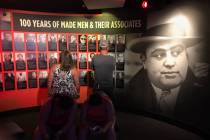Graffiti taggers pose freeway risk, cost public millions
What kind of people would shimmy up a metal pole, crawl along a narrow ledge some 40 to 50 feet above steadily moving traffic on a major freeway and risk their lives just to pull spray cans from their pockets and deface two large, green traffic signs, with the ultimate purpose of creating havoc for drivers?
And yet it happens all the time. Recently motorists along heavily traveled northbound U.S. Highway 95 found it nearly impossible to determine whether they were exiting onto Summerlin Parkway or Rainbow Boulevard.
Had there been the slightest hesitation by one or more drivers traveling at 60 to 70 mph while trying to read through the graffiti-smeared signs, there could have been a monumental traffic pileup, possibly of deadly proportions.
“Graffiti vandals see what they do as a challenge,” said Metropolitan Police Department Detective Scott Black, head of graffiti enforcement. “To them, their goal is a form of recognition from the public, and it brings them a kind of fame among their peers.
“I’ve been involved with graffiti vandalism for more than 14 years. I’ve made lots of arrests,” Black said. “I’ve gotten to talk to these criminals. I’ve gotten to know who they are. Graffiti, which is not art but a crime, puts vandals into an upper stratum among their peers.
“And they’re not afraid to be arrested,” he said, adding that within some groups, “they need a graffiti arrest on their record just to qualify for membership.”
A team from the Nevada Department of Transportation, skilled in the hazards of graffiti removal in such situations, eventually halted traffic for a time to clean up the exiting signs along Highway 95.
But there has been “a rash of graffiti incidents along (Highway) 95,” Black stated. “It’s no challenge for vandals to deface some wall. Their credibility doesn’t rise much from that. So, they seek the tough challenges. And, in their minds, climbing high to deface traffic signs gives them an element of status.”
Jace Radke, spokesman for the city of Las Vegas, said, “Graffiti is a constant issue” in Summerlin as well as every other sector of the city.
“We had some graffiti recently on Town Center (Drive), near Summerlin Parkway, heading toward Summerlin Hospital. It was cleaned up immediately,” he said.
The annual cost to the state, county and city of cleaning up graffiti has been estimated by officials at $30 million.
“That’s a very conservative estimate,” Black said. “It doesn’t include property damage, such as acid used on windows, or the defacing of churches, graveyards and other private property.”
He said the Regional Transportation Commission of Southern Nevada, the Department of Transportation and other public entities “spend enormous amounts, not only in cleanup but in repairs and replacement.”
The Legislature, in its last session, enacted Senate Bill 237, which increases the level of criminal penalties for those found guilty of defacing public property.
“I’m amazed by the amount of risk these graffiti taggers will take,” said Damon Hodge, a spokesman for the Department of Transportation, when asked if the department had collected any data dealing with the psyche of taggers.
“We have no information pertaining to the mind-set of anyone who would risk life or limb to smear graffiti on traffic signs high above some busy freeway.”
The appearance of graffiti on public and private property has escalated, especially during the past two decades. Ironically, in some quarters, graffiti is looked upon as a form of “art.” However, those faced with the cost and task of removing the mess are more of the opinion that the reference to some graffiti as art does nothing more than encourage the vandals.
For example, the Museum of the City of New York is showing a collection of graffiti “art” through Aug. 24. The presentation depicts the scrawling of the sides and roofs of subway cars parked in a city rail yard.
In Las Vegas, the problem has grown steadily over the years, as has the cleanup cost. Former Mayor Oscar Goodman, expressing outrage at one point during his final term several years ago, went so far as to declare that graffiti taggers should have their thumbs cut off.
Herb Jaffe was an op-ed columnist and investigative reporter for most of his 39 years at the Star-Ledger of Newark, N.J. His most recent novel, “Double Play,” is now available. Contact him at hjaffe@cox.net.












